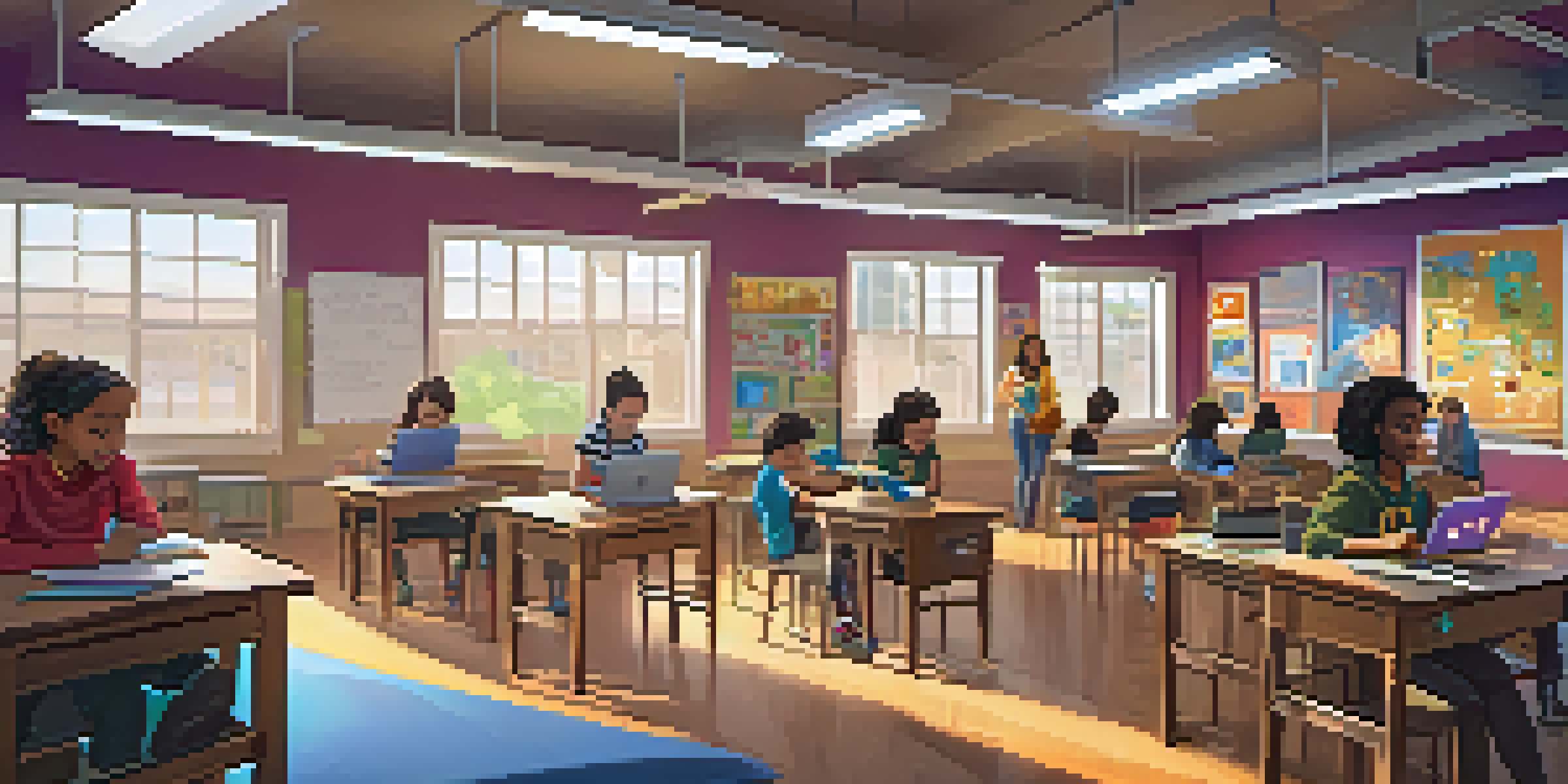Integrating Digital Storytelling in STEM Education

Understanding Digital Storytelling in Education
Digital storytelling combines the art of storytelling with digital tools, creating a unique way to share knowledge. In education, it allows students to express their understanding through multimedia elements like videos, podcasts, and animations. This approach not only engages learners but also caters to various learning styles, making complex concepts more accessible.
Storytelling is the most powerful way to put ideas into the world today.
Imagine a student explaining the water cycle not just through a textbook but by creating an animated video. This method not only reinforces their understanding but also makes the learning process enjoyable and interactive. By integrating personal narratives with scientific concepts, students can connect emotionally, enhancing retention and comprehension.
In STEM education, where abstract concepts can be daunting, digital storytelling acts as a bridge. It fosters creativity, allowing students to visualize and communicate their ideas effectively. As they weave narratives around scientific principles, they gain a deeper appreciation for the subject matter and develop critical thinking skills.
The Benefits of Digital Storytelling in STEM Learning
One of the primary benefits of digital storytelling in STEM is increased engagement. Students are more likely to participate actively when they can craft their own narratives, making the learning experience feel personal and relevant. This active participation often leads to higher motivation and better academic performance.

Moreover, digital storytelling promotes collaboration among students. When they work in groups to create a story, they learn to communicate ideas effectively, listen to diverse perspectives, and build teamwork skills. These collaborative efforts mirror real-world scientific endeavors, where teamwork is essential for problem-solving and innovation.
Engagement Through Storytelling
Digital storytelling enhances student engagement by allowing them to create personal narratives that make learning feel relevant and enjoyable.
Additionally, integrating storytelling into STEM helps develop essential 21st-century skills. As students navigate digital tools and articulate their ideas, they enhance their digital literacy and communication skills. These competencies are invaluable not just in STEM fields but also in any career path they choose.
Practical Ways to Integrate Digital Storytelling
Integrating digital storytelling into STEM education can be as simple as assigning projects where students create a short video or podcast on a scientific topic. For instance, a class could explore renewable energy sources and then produce a digital story that highlights the importance of sustainability. This hands-on approach encourages deeper exploration of the subject matter.
The art of storytelling is crucial to education, as it helps students connect emotionally with their learning.
Teachers can also utilize platforms like StoryMapJS or Adobe Spark to help students visualize their stories. These tools offer user-friendly interfaces that allow students to combine text, images, and data. By guiding students through the story creation process, educators can facilitate discussions that deepen understanding of STEM concepts.
Another effective method is to incorporate digital storytelling into assessments. Rather than traditional tests, educators can ask students to submit a digital story that demonstrates their grasp of a particular topic. This not only evaluates their understanding but also provides them with an opportunity to showcase their creativity.
Challenges of Implementing Digital Storytelling
While the benefits are significant, integrating digital storytelling in STEM education does come with challenges. One major hurdle is the availability of resources, such as access to technology and software. Schools with limited budgets may struggle to provide the necessary tools for students to create their stories, which can hinder the implementation of this innovative approach.
Additionally, some educators may feel apprehensive about incorporating digital storytelling into their curriculum. They might worry about their own proficiency with technology or how to assess students’ digital projects effectively. Overcoming this barrier requires professional development and support, ensuring teachers feel confident in their ability to guide students.
Collaboration and Skills Development
This approach promotes collaboration among students, helping them develop essential communication and teamwork skills while working on projects.
Finally, there’s the challenge of ensuring that the storytelling remains focused on the STEM content. It’s easy for narratives to drift into entertainment without a solid educational foundation. Educators must strike a balance, providing guidance to help students stay on topic while still allowing for creative expression.
Real-World Examples of Digital Storytelling in STEM
Numerous schools have successfully integrated digital storytelling into their STEM curriculum, showcasing its effectiveness. For example, a high school in California implemented a project where students created interactive timelines about significant scientific discoveries. This not only helped them learn about history but also connected them to the scientific method and its evolution.
Another inspiring case is a middle school in New York that had students produce podcasts on environmental science topics. By researching and discussing issues like climate change, the students developed a deeper understanding of the subject while honing their research and communication skills. This approach made the learning process relevant and engaging.
These examples highlight how digital storytelling can transform traditional STEM education. By allowing students to share their insights and discoveries creatively, educators can foster an environment of curiosity and enthusiasm for learning.
The Role of Educators in Facilitating Digital Storytelling
Educators play a crucial role in the successful integration of digital storytelling into STEM education. They are responsible for creating a supportive environment where students feel comfortable expressing their ideas. This means offering guidance, resources, and encouragement throughout the storytelling process.
Moreover, teachers can model effective storytelling techniques, demonstrating how to blend narrative with factual information. By sharing examples of successful digital stories, educators can inspire creativity and show students how to communicate complex ideas effectively. This mentorship fosters a culture of innovation and exploration.
Future Trends in Digital Learning
Emerging technologies like VR and AI are set to further transform digital storytelling in STEM education, making learning even more immersive and personalized.
Finally, educators should assess and reflect on the impact of digital storytelling on student learning. By gathering feedback from students and analyzing their projects, teachers can refine their approaches and ensure that storytelling remains a meaningful part of the curriculum.
Future Trends in Digital Storytelling and STEM Education
As technology continues to evolve, so too will the possibilities for digital storytelling in STEM education. Emerging tools like virtual reality (VR) and augmented reality (AR) are set to revolutionize how students engage with content. Imagine students exploring the solar system in a VR environment while narrating their experiences—this level of immersion could transform learning.
Additionally, the rise of artificial intelligence (AI) may offer new avenues for personalized storytelling experiences. AI tools could help students craft narratives tailored to their interests and learning styles, making education even more engaging. This adaptive learning approach could cater to diverse needs, ensuring that every student can thrive.

These trends suggest a bright future for digital storytelling in STEM education. By staying abreast of technological advancements, educators can continually enhance their teaching methods, making learning more interactive and impactful for students.